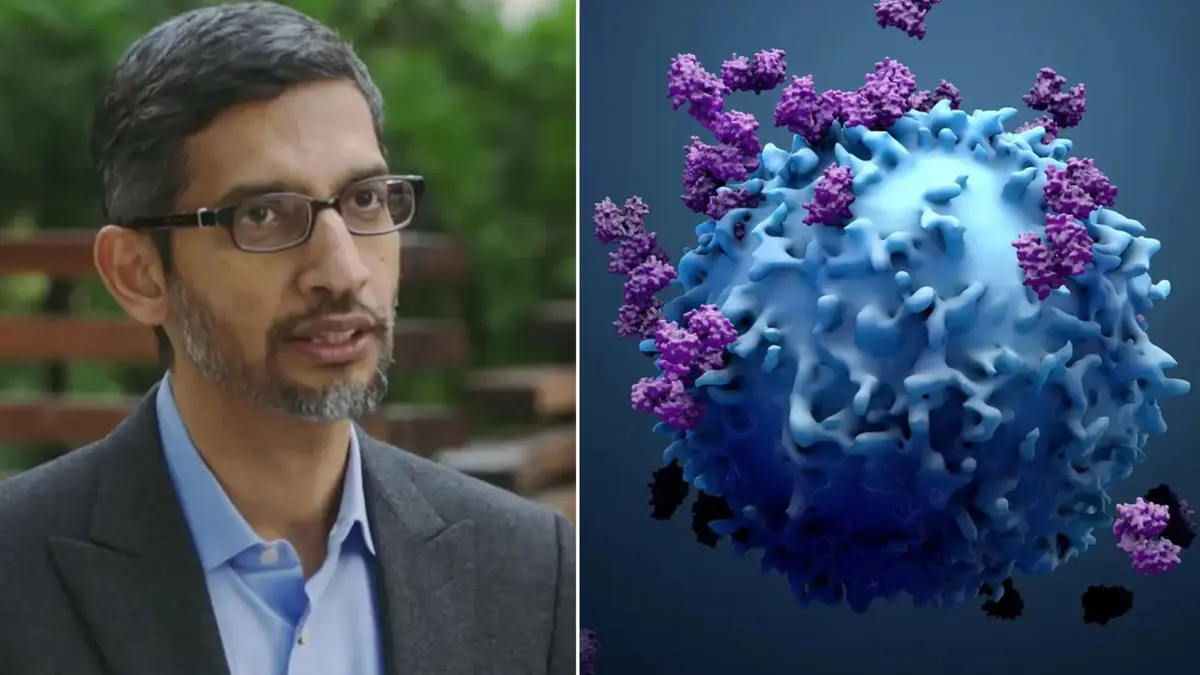In a bold stride beyond AI-assisted diagnostics, Google Research—alongside DeepMind and Yale School of Medicine—has unveiled a revolutionary approach to cancer therapy discovery powered by an advanced AI foundation model. Instead of merely analyzing existing medical data, this AI system generated a novel therapeutic hypothesis for treating cancer, a concept that was later validated experimentally in lab-grown human cells.
This breakthrough elevates AI from being a passive interpreter of medical knowledge to an active scientific collaborator—a leap that could redefine the future of oncology research and precision medicine.
From Prediction to Innovation: Google’s Cell2Sentence-Scale 27B Model
At the heart of this advance is the Cell2Sentence-Scale 27B (C2S-Scale 27B) model, an open-architecture LLM (Large Language Model) based on Google’s Gemma family. Unlike conventional LLMs built for text generation, C2S-Scale 27B is engineered specifically for understanding and interpreting single-cell biology and microenvironmental signaling. It boasts 27 billion parameters trained on vast datasets of cancer biology, immunology, and molecular interaction data.
Its goal? To discover how to convert “cold” tumors—those that evade the immune system—into “hot” tumors that can be targeted by immunotherapies.
Dual-context virtual screening at scale
The model performed a virtual screen of more than 4,000 compounds in a dual-context setup: assessing their impact both within cancer cells and their surrounding immune environment. From this expansive molecular search, it identified a potential combination:
- Silmitasertib, a CK2 kinase inhibitor
- In conjunction with low-dose interferon, a common immune-modulating agent
This AI-proposed combination enhanced the tumor’s antigen presentation capabilities—making the cancer cells more visible to the immune system. Importantly, this was not just a computational prediction: it was validated in laboratory experiments using live human cancer cells, confirming that the model’s theoretical hypothesis had real-world biological impact.
“This marks one of the first examples where an AI model has successfully generated a biological hypothesis that was subsequently proven in living cells,” Google Research said in their official announcement.
Read the full announcement from Google here
DeepSomatic: Detecting Hidden Cancer Mutations with AI
In parallel to the therapy discovery project, Google also introduced DeepSomatic, a deep learning framework designed to uncover somatic mutations—those genetic alterations that occur in tumor cells but not in healthy tissue. These mutations are notoriously difficult to identify due to noise, sequencing errors, and biological variability.
Built using convolutional neural networks (CNNs), DeepSomatic was trained to distinguish subtle genomic variations that traditional bioinformatics pipelines often miss. It has demonstrated superior performance across a wide array of DNA sequencing platforms, making it versatile and generalizable.
A new frontier in precision oncology
By detecting mutations with greater sensitivity and accuracy, DeepSomatic enhances tumor profiling—a key step in matching patients to targeted therapies. Importantly, it was designed to work even on previously unseen cancer types and on diverse preparation protocols, addressing a critical bottleneck in genomic diagnostics.
Explore DeepSomatic on Google Research
A Shift in Scientific Paradigms: AI as Co-Researcher
This suite of tools from Google marks a conceptual shift in how AI contributes to science. Traditionally, AI in healthcare has been relegated to tasks such as image classification (e.g., detecting cancer in scans), speech transcription, or patient record summarization.
Now, models like C2S-Scale 27B and DeepSomatic are showing that AI can autonomously propose new hypotheses, screen drug interactions, and potentially accelerate the path from discovery to therapy.
“This isn’t just AI assisting researchers. It’s AI working alongside researchers—suggesting ideas, interpreting complex signals, and guiding experimental design,” said Google Research in a blog post.
This model of AI as a scientific partner could have far-reaching implications across biomedicine, synthetic biology, and drug development.
Limitations and Cautions: Not a Cure—Yet
While the results are promising, it’s important to recognize where the research currently stands:
- Early-stage findings: These are preclinical discoveries, validated in vitro but not yet in animals or humans. Further investigation is required before any clinical applications can be considered.
- Tumor heterogeneity: Cancer is not a uniform disease. The therapy pathway discovered may work in certain tumor microenvironments but not others.
- Regulatory hurdles: The leap from lab validation to approved treatment requires years of trials, patient safety protocols, and regulatory review.
Sundar Pichai called the work a “milestone for AI in science,” but also acknowledged the need for careful, rigorous progress.
Why This Matters for the Future of Cancer Research
1. Expanding drug discovery possibilities
AI can rapidly explore therapeutic landscapes that would take human researchers years to analyze. This opens the door to finding unexpected combinations of existing drugs, repurposing them for new therapeutic strategies.
2. Lowering research barriers
Because Google’s Gemma model architecture is open-source, smaller research labs and institutions in low-resource settings could access cutting-edge AI tools without massive infrastructure.
3. Transforming immunotherapy
Immunotherapies like checkpoint inhibitors have revolutionized cancer treatment—but many tumors remain resistant. If AI can help uncover ways to “unmask” these cancers to the immune system, it could dramatically increase the pool of treatable patients.
What’s Next?
Key developments to watch include:
- Preclinical trials using silmitasertib + interferon combinations to test safety and efficacy in animal models
- Peer-reviewed publications detailing C2S-Scale 27B’s architecture, datasets, and training methods
- Open-source rollouts of DeepSomatic and similar genomic AI tools to democratize precision oncology
- Policy and ethics frameworks for evaluating AI-generated hypotheses and sharing data responsibly
As Google moves forward, the broader scientific community will be watching closely—not just for new treatments, but for a new way of doing science.
Final Thoughts
This research marks a turning point: from AI as an analytical assistant to AI as a creative, generative collaborator in medical science. While we’re still far from declaring AI a cancer cure, what Google has accomplished with C2S-Scale 27B and DeepSomatic offers a compelling preview of what the future could hold.
If proven robust and clinically translatable, this could be one of the most significant uses of AI in human health to date.
Stay tuned at Superintelligence News as we track the evolving frontier where machine learning meets molecular medicine.









